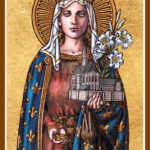St. Elizabeth of Hungary
St. Elizabeth of Hungary
St. Elizabeth of Hungary
When they lived:
St. Elizabeth of Hungary, also known as St. Elizabeth of Thuringia, lived during the 13th century.
Where they lived:
St. Elizabeth was born in Sárospatak, Hungary, in 1207, and she spent much of her life in the region of Thuringia,
which is now part of modern-day Germany.
Notable world events during the time of their life:
- The Crusades (1096-1291): The Crusades were a series of religious and military campaigns
during the medieval period, aimed at reclaiming the Holy Land from Muslim rule. - Mongol Invasions (1206-1294): The Mongol Empire, under the leadership of Genghis Khan and his
successors, launched a series of invasions that reshaped the Eurasian continent. - The Fourth Lateran Council (1215): This was a significant event in the history of the Catholic
Church, addressing various issues and impacting religious practices during Elizabeth’s lifetime. - The Magna Carta (1215): King John of England signed the Magna Carta in 1215, which was a crucial
document that limited the power of the monarchy and granted certain rights to English nobles and freemen.
Her Patronage:
- The Poor and the Sick: St. Elizabeth’s dedication to caring for the poor and the sick makes
her a patron saint for charitable works and hospitals. - Bakers: St. Elizabeth is regarded as the patron saint of bakers and those who provide sustenance
to others, as she is associated with the act of carrying bread to the poor. - Homeless People: St. Elizabeth’s acts of kindness extended to the homeless and those without
shelter, making her a patron saint for the homeless and destitute. - Widows: Her empathy and resilience in the face of adversity make her a patron saint for
widows, inspiring them to find solace in their faith. - The Kingdom of Hungary: As a revered figure in Hungarian history, St. Elizabeth is considered
the patron saint of the nation.
St. Elizabeth’s life was filled with remarkable acts of kindness, and her legacy continues to inspire people around
the world to show compassion and love to those in need, making her a beloved and influential figure in both
religious and secular contexts.
Early Life
Saint Elizabeth of Hungary had several notable European figures in her line of ancestry. For example, her mother’s sister was Hedwig of Andechs, the wife of Duke Heinrich I of Silesia. Other notable figures in her line of ancestry included Vladimir the Great of Kievan Rus.
She lived in the castle of Posonium until the age of four. Soon after her fourth birthday, Saint Elizabeth of Hungary was brought to the court of the rulers of Thuringia in central Germany. It was here that she was betrothed to Louis IV of Thuringia. This union was done to create political alliances.
From that day on, Saint Elizabeth of Hungary was raised by the court of Thuringia. At the age of fourteen, in 1221, she married Louis. They were happily in love.
Saint Elizabeth’s Turn to the Church
In 1223, the Franciscan friars visited Saint Elizabeth of Hungary. During their visit, she learned of the ideals of Francis of Assisi. She also started to live by these ideals, and Louis seemed not to be opposed to this.
During this time, the priest and later inquisitor Konrad van Marburg gained influence over Elizabeth. As a result of this, he became Elizabeth’s confidant. In 1226, great floods and natural disasters began to plague Thuringia. As a result of the floods, Louis represented Frederick II at the Imperial Diet held in Cremora.
As Louis was absent at home, control of the home was given to Saint Elizabeth. It was here that her charitable work was more noticed by the public. She distributed alms to all parts of their territory and gave away state robes to the poor as well as state ornaments.
11 September 1227, the day that Saint Elizabeth’s beloved died in Italy The loss of her beloved absolutely devastated her. Furthermore, there were also several bitter arguments over the dowry owed to Saint Elizabeth after the passing of her beloved. As a result of this, she moved from the court at Wartburg to Marburg, Hesse.
Following the death of her beloved, Saint Elizabeth made solemn vows to Konrad. These vows were like those of a nun and included celibacy and complete obedience to Konrad as her confessor and spiritual dictator. This proved to be a mistake on the part of Elizabeth. Why?
This is because Konrad’s treatment of Elizabeth was harsh, with several punishments involving physical beatings and sending away her three children. Saint Elizabeth was also held somewhat hostage in Pottenstein, the castle of her uncle. This was because this was a vow to get Elizabeth to remarry. Against this, she threatened to cut off her own nose so nobody would find her attractive enough to marry.
As part of her charitable work, which she held so dear, she continued throughout this time to carry it out. Saint Elizabeth also built a hospital at Marburg. This hospital was for the poor and sick. She used the money from her dowry to build the hospital and stayed there with her companions to look after patients that needed care.
The Death and Canonization of Saint Elizabeth of Hungary
At the ripe young age of 24, in 1231, Saint Elizabeth of Hungary passed away in Marburg. She was canonized on May 24, 1235, by Pope Gregory IX in Italy. Her body was laid to rest in a golden shrine, which can still be seen today in Marburg.
5 Interesting Facts About St. Elizabeth of Hungary
- Saint Elizabeth’s shrine was the absolute center of German
pilgrimages during the 14th and 15th centuries. - A church was built in her name, called the Elizabethkirche. It is
mainly a Protestant church but has spaces for Catholic worship. - After her death, the Teutonic Order adopted Saint Elizabeth as
their secondary patroness. - Saint Elizabeth of Hungary is remembered by the Church of England.
with her feast day celebrated on November 18. - After her death, it was reported that miracles happened at her
grave and at the hospital she built.
Prayer to St. Elizabeth of Hungary
Dear Saint Elizabeth, you were always poor in spirit, most generous toward the poor, faithful to your husband, and fully consecrated to your Divine Bridegroom. Grant your help to widows and widowers and keep them faithful to their heavenly Lord. Teach them to make use of their time in the service of God, our Lord. Amen.



